
After Windows Vista has been installed and a few settings of the Start menu and the desktop have been changed, it is time to make Windows Vista more user-friendly.
The shortcut System in the Control Panel shows a basic system overview with the calculated Windows Experience Index to measure the capabilities of the hardware. The total index value (the Base score, with a maximum score of 6) equals the lowest value of the five components (the weakest chain), each covering hardware like the processor, memory (RAM), graphics, gaming graphics and the primary hard disk. This score will predict whether the hardware is suitable for the different features within Windows Vista and which hardware replacements would most improve the overall system performance.

Clicking the link Windows Experience Index shows the individual hardware scores.
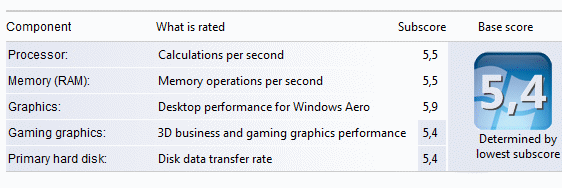
|
|
NOT POSSIBLE TO CALCULATE THE EXPERIENCE INDEX?
If it is not possible to (re)calculate the Experience Index, in most
cases it can be solved by deleting the files in the folder C:\Windows\Performance\WinSAT\DataStore
using the Windows Explorer (if needed change the explorer settings to make
hidden files visible). Start the
registry editor as well and
delete the registry value PerfcplEnabled in the following registry keys (if
present): |
DETAILED RESULTS OF THE EXPERIENCE INDEXThe total score of the experience index equals the lowest value of the five components However, it's not clear what the values of the components are exactly based on, which makes it hard to do hardware testing to increase the scores and the overall performance. Fortunattely, a report of the more detailed calculations is saved in XML-files, stored in the folder C:\Windows\Performance\WinSAT\DataStore. The command WINSAT.EXE formal (use the Command Prompt) starts a calculation of the experience index, the command WINSAT.EXE /? shows the other options for this command. |
CHANGING THE PRODUCT KEYIn contrast with earlier Windows versions, it is possible to change the Windows Vista product key by clicking the link Change product key at the bottom of the window View basic information about your computer (Control Panel, System). After a change in product key, Windows Vista requires to be activated again to verify the new key. This option saves time in case of an installed but illegal version of Windows Vista. The option to reset the product key is not always present, especially in OEM-versions. |
SUPPORT FOR MULTIPLE LANGUAGESWould you like to change the user interface language (e.g. when the computer has been bought abroad)? The most expensive consumer version Windows Vista Ultimate, supports multiple languages. At setup, the default language is installed; the additional languages can be added through the Microsoft Update after the installation has been completed. After the language update has been added, the user interface language can be changed by the control panel item Regional and Language Options, tab Keyboard and Languages, option Choose a display language. The other Windows Vista versions only support one language for the user interface, the free tool Vistalizator (download: www.froggie.sk) can be used to bypass this limitation! This tool uses the original language files, but be aware that this workaround is not supported by Microsoft! Uninstall and hide update KB971033 in case Vistalizator is causing problems with the Microsoft license! |
The advanced system settings are available by System in the Control Panel, option Advanced system settings (at the left in the task pane).
Tab System
Protection
When there is any trouble with the Windows operating system, it is nice to know
Windows has a build-in system restore
to a previously created restore point.
The recovery data is stored in the folder System Volume Information
(present on each partition) and can be recovered any moment. But, be careful using this feature, before you know you are worse of then
before (besides that you won't be the first to lose personal data unexpectedly). In Windows Vista,
System Restore has an
additional feature to be able to restore single files to a previous version,
called shadow copies.
Restoring a shadow copy of a file saved by System Restore can be done by
right clicking the file in the Windows Explorer, option
Properties,
tab Previous Versions.
When image software is used to create an image of the Windows partition, System Restore (shadow files included!) can be deactivated, which saves many Gb's of hard disk space. Deactivating System Restore for the Windows partition is done on the tab System Protection, by activating a partition with personal data (D:), restoring shadow copies is still available for these files (be aware that in case of a multiboot system, System Restore will probably result in problems on partitions which are shared between the different operating systems).
DISABLE SYSTEM RESTORE AS LATE AS POSSIBLEDisable System Restore as late as possible, at least until all hardware drivers and software are installed and working properly. If the installation of hardware and/or software creates a problem, it is still possible to restore the computer to a system restore point before the problems occurred. If all hardware and software are installed and essential changes in the system settings have been made, it is time to disable system restore and to create a system image instead. An image of the Windows partition is more reliable and accurate then System Restore, in case of system troubles. |
Tab Remote
Within Windows Vista, it is easy to give someone Remote Assistance to take over the
control of the computer, using the internet connection. If you are not able to
fix a problem yourself, someone can show you using a remote connection while sitting
behind his own computer. This person gets control over the computer, so only give
people access who you can trust. Remote Desktop makes it possible to give
users almost full control over the computer using a remote connection. If Remote
Assistance and/or Remote Desktop are not used (in most cases), it is better to disable
this feature for security reasons.
Tab Computer Name
On this tab, the computer is given a name which makes it possible to identify
the computer by other computers in the same network. This name must be unique
for the network it is attached to, while the workgroup name must be equal for
all computers.
Visit the page creating a
(wireless) network for more information about connecting computers to a
network.
Tab Advanced
On the tab Advanced many system related settings can be changed and/or
optimized. At the third button Settings (sub Startup and Recovery)
the option Automatically restart can be disabled. This prevents Windows
Vista to restart automatically in case of system errors, which makes it easier
to investigate the cause of the problem.
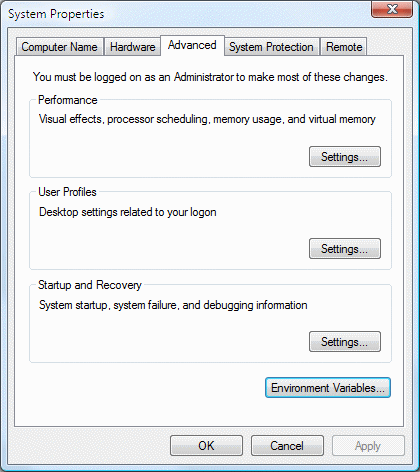
The first button Settings (sub Performance) opens the window Performance Options. One of the options is to adjust the visual effects to achieve a better performance (changing the visual settings is discussed on the page about the Start menu and the Desktop). To change the amount of virtual memory (a slower alternative to the faster RAM memory) addressed to the paging file can be changed on the tab Advanced of the same window, button Change. In most cases the Windows partition (C:) is the most suitable for the paging file (always use the fastest hard disk for the Windows partition and the paging file). The default size of the paging file can be changed by deactivating the option Automatically manage paging file size for all drives, selecting the partition and changing the initial and maximum size. In most cases the total amount of RAM is a good value for both the initial size and the maximum size (set both higher when the computer is used for processing multiple large files like pictures or video's). Don't forget to click the button Set to confirm each change in settings. For the changes to take effect, a restart of the computer is necessary.
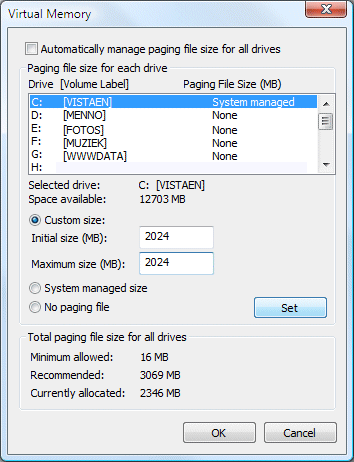
CLEARING THE PAGEFILE AT SHUTDOWNThe virtual memory uses a paging file which is stored in the file PAGEFILE.SYS on C: by default. To make sure someone else is not able to view the content of this file, this file can be overwritten every time Windows is shutting down. For this purpose, the DWORD value ClearPageFileAtShutdown with the value 1 has to be added to the registry key HKLM\SYSTEM\CurrentControlSet\Control\Session Manager\Memory Management (deleting the registry value or changing the value to 0 will disable this feature). As a result, Windows will shut down remarkably slower. For this reason, only apply this tweak in case it is really necessary for privacy purposes. |
READYBOOST AND READYDRIVEIf there is not enough RAM memory available, the system starts using the slower paging file. Because the paging file is stored on the hard disk, it will slow down the system performance. Fortunately ReadyBoost is a better alternative because it uses the relatively faster flash memory (a USB-stick, Compact Flash (CF)- or Secure Digital (SD)-cards) to improve the system performance. ReadyBoost requires 250 Mb to 4 Gb of free space, at least 2,5 Mb/sec read speed and formatted with the FAT32 file system. If the connected flash memory meets these specifications, Windows will show a request whether the memory must be used to improve the system performance. The ReadyBoost settings can be changed on the tab ReadyBoost (start the Windows Explorer, click right on the flash memory and chose Properties). The used paging file will be encrypted using AES 128-bits encryption, which ensures that the written data can't be read if the memory stick has been stolen. BTW: the advantages of ReadyBoost are hardly measurable while using a system with enough RAM memory! ReadyDrive (where the flash memory is integrated in a hard disk) uses a similar concept. Data written to the hard disk is (temporarily) stored on the flash memory (as well). Because this memory is much faster than the hard disk itself, it speeds up the system. The second advantage is the power saving, because there is no need to run the hard disk when the data can also be stored on or read from the flash memory as well. Because the hard disk is used less frequently, it extends the hard disk service life as well. The relatively low speed of a USB2.0 connection compared to the hard disk connection makes ReadyDrive a better alternative to ReadyBoost. The power saving characteristic of ReadyDrive makes it especially valuable for laptops. |
But there are more possibilities to optimize Windows. The option Performance Information and Tools in the Control Panel shows an overview of the different components of the earlier mentioned Windows Experience Index. The task pane at the left of this window shows some additional tasks to improve the system performance. This overview probably implies that the mentioned tasks will improve the Windows Experience Index however, this is not the case.
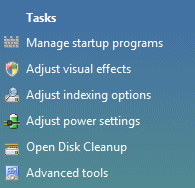
Task Manage startup programs
The first task Manage startup programs in the task pane starts the Software
Explorer of Windows Defender. The
Software Explorer is divided
in four categories: Startup programs, Currently Running Programs,
Network Connected Programs
and Winsock Service Providers.
The first category makes it
possible to disable multiple applications which startup with Windows
(this procedure is similar to MSCONFIG).
The second category Currently Running Programs
makes it possible to analyze and
terminate the currently running processes. Terminating processes can be done
with the
Windows Task manager (activated by the key combination CTRL-SHIFT-ESC), tab
Processes as well.
The number of running processes seems to be lower in comparison to earlier Windows versions, but this is not the case. Both the Software Explorer and the Windows Task manager separate the processes started by the user account and the ones started by the system. The full list becomes visible with the buttons Show for all users (Software Explorer) and Show processes from all users (Task manager). The pages about the Windows Services and MSCONFIG describe in detail how to disable processes permanently to speed up the system.
Windows Defender is only an additional security tool against malicious and unwanted software, it does not operate as antivirus software. To change the default Windows Defender settings, follow the link Tools. Disable the membership of the online community Microsoft SpyNet if it is not desired to send personal information to the online community. Select Options to change the basic Windows Defender settings.
The other tasks (task pane Performance Information and Tools)
The second task Adjust visual effects
makes it possible to lower the necessary graphical calculations for visual
effects, which improves the performance (disabling visual effects is discussed on
the page about
the Start menu and the Desktop). The third task Adjust indexing options
makes it possible to adjust the settings for indexing the locations with personal files (for
more information, visit the page about the
Windows Vista functionalities).
The fourth task Adjust power settings
makes it possible to change the different power settings like turning off the
display and putting the computer to sleep automatically
after a certain amount of time. The fifth task
Open Disk Cleanup can be
used to remove programs and features and to delete unnecessary files (like deleting the
large hibernation file, the System Restore points and Shadow copies. For
more information about deleting unnecessary files, visit the page
Disk Cleanup and Disk
Defragmenting. The last task Advanced tools
does not do much more then reporting system performance issues.
The Windows Explorer is used to browse and manage the content of hard disks, CD players and other hardware which are able to store data. With a few clicks files are copied, new folders are created and CD's are burned. By default there is a shortcut to the Windows Explorer in the folder All Programs, Accessories of the Start menu, an awkward location for a frequently used program. To save a lot of clicks, copy the shortcut to a more accessible location like the desktop (click right on the shortcut and select Send To, Desktop (creating shortcut) or pin to the Start menu (click right on the shortcut and select Pin to Start menu). The Windows Explorer can be opened quickly as well by the start button: right click the Start button and select Explore.
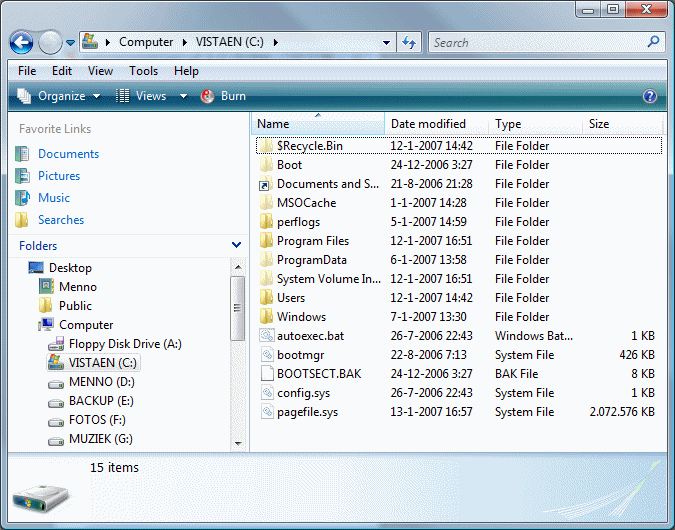
Changing the default settings
The new Windows Explorer shows the relative path in the address bar,
it doesn't take long to get used to navigating through these relative paths. The
width of the available space for the navigation tree on the left side is too small to show all folders, but can be widened up by dragging the vertical
separating line to the right. The menu bar is hidden by default, but can be
shown temporarily by pressing the left ALT key. Click the button
Organize,
option Layout, Menu Bar to enable the permanent visibility of the menu bar.
The system files are hidden by default, which is a fine setting for the less experienced users. If this setting is less practical, disable this option. Click the button Organize, Folder and Search Options, tab View, and change the following settings:
The other options are shown below:

If the hard disk is not that fast, it can be useful to enable the option Always show icons, never thumbnails to replace the miniature pictures by the default icon. The option Launch folder windows in a separate process uses more memory, but prevents shutting down all explorer windows after a crash of the Windows Explorer (if this is no problem, leave this option disabled). The option Use check boxes to select items can be useful to select multiple files.
WINDOWS EXPLORER TIPSPressing the F5 key will refresh the show windows (just like the Internet Explorer). The key combinations CTRL-C/CTRL-X will copy/cut files and folders and CTRL-V will paste them at the current location. Pressing down the SHIFT or CTRL key can be used to select multiple files/folders and the key combinations SHIFT-HOME and SHIFT-END will jump to the beginning and the end of the list. |
By right clicking the recycle bin, option Properties the settings for every partition can be changed. Disabling the option Display delete confirmation dialog saves a click each time a file is deleted. Holding down the SHIFT key while deleting files and/or folders, will delete the files without showing up in the recycle bin.
TIP: If you have been too enthusiastic deleting files, they can still be restored (even if they are removed from the recycle bin) with recovery tools like PC Inspector File Recovery (download: www.pcinspector.de, run as administrator) and Recuva (download: www.recuva.com). When deleted files are overwritten by new files, they are no longer recoverable (note that installing a recovery tool will overwrite deleted file, therefore install a recovery tool before there are any files to recover…).
The option Sound in the Control Panel, tab Sounds can be used to change or disable the sound schemes. If the Windows sounds are irritating or not useful, disable them by selecting the sound scheme No Sounds. It is also possible to disable or change the different sounds effect individually. The Volume Mixer icon in the system tray can be used to adjust the volume (also available by the option Taskbar and Start Menu in the Control Panel, tab Notification Area).
During the Windows setup the user is asked to select the default keyboard setting. This setting can be changed at Regional and Language Options in the Control Panel, tab Keyboards and Languages, button Change keyboards. If there is more than one input language defined then it is possible to switch between the input languages by pressing the left ALT key en the right SHIFT key. Because this key combination is hit accidently on a regular basis, the change in keyboard layout can be quite irritating. If you are not aware of the effect of this key combination, a reboot is necessary to fix the changed keyboard layout. To make sure this does not happen anymore, delete the input languages which are not used by default.
The default keyboard layout is United States-International has the side effect of not showing the quotation marks immediately after pressing the quotation key (' or "). If you do not like this behavior select another keyboard layout (like US).
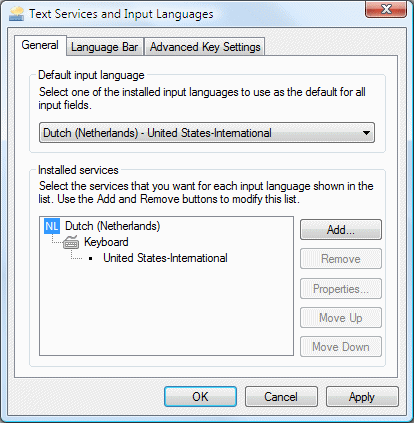
THE EURO SIGNOn most keyboard, the € sign is placed on the same key as the number 5. Use this key in combination with the right ALT key to print the euro sign. The euro sign can be printed with the code 0128 on the numeric keyboard in combination with holding down the left ALT key. |
The option Programs and Features in the Control Panel shows the currently installed programs. The link View installed updates at the left in the task pane can be used to show (and uninstall if desired) the installed updates as well. The link Turn Windows features on or off in the task pane makes it also possible to add or remove specific Windows features.
To prevent the screen from burned in pixels, enable a screensaver: open the Personalization window, option Screen Saver. The most valuable screensaver is Photos (shows the favorite pictures based on the star system of Windows Photo Gallery). This window also has the option to enable or disable the logon screen after inactivating the screensaver (option On resume, display logon screen). This will prevent unauthorized persons to gain access to the user account at the moment the screensaver is active.
Instead of a screensaver, the monitor can also be turned off automatically after a certain amount of time has passed. This saves energy and extends the life of the monitor. These power settings are available by clicking the link Change power settings (also available by Power management in the Control Panel), task Change when the computer sleeps (at the left in the task pane). Fill in the time to wait (from the point of no activity) until the monitor has to be turned off automatically. The time to wake-up of modern monitors is very low, so it won't cause much delay.
Windows Vista uses three different features to turn the computer into a power saving mode: sleep, hibernation and hybrid sleep. The feature sleep (comparable to standby in Windows XP) is an energy saving mode where the computer stays 'on' to be able to awake within a few seconds. The disadvantage is the loss of data (which hasn't been saved) when there is a loss of power. The hibernation (comparable to sleep in Windows XP) actually turns off the computer after the memory has been saved into the file C:\HIBERFIL.SYS. After turning on the computer, the data is loaded into the memory and to wake up Windows relatively quick compared to a reboot. Hybrid sleep combines both sleep and hibernation for the best result (attention: Windows Vista calls this combination sleep!). The hybrid sleep stores the memory to the hard disk followed by a power saving made. In this mode no data will be lost while the computer returns from standby relatively quick.
ATTENTION: The hybrid sleep can only be activated when the motherboard supports this feature. If hybrid sleep is supported then the option to hibernate won't be present! If needed, the option to hibernate can be added with the command POWERCFG /hibernate ON in the Command Prompt (Start, All programs, Accessories). Start the Command Prompt with additional administrator rights by right clicking it and to select Run as administrator!
The hybrid sleep is not applied with laptops because they don't have to handle the sudden loss of power. At the moment the battery loses power while the laptop is in sleep, then the computer will become active again go into hibernate (which doesn't use any power) to prevent the loss of data. Remember that it is wise to reboot Windows once in a while to prevent problems.
Changing the sleep button to a shut down button
The Start menu has got a yellow button by default to hibernate (sleep) the computer. The other
options (like switching user, lock, shut down, restart
and log off) are hidden behind the arrow. The option to hibernate can be changed to shut down the computer
(the color of the button changes from yellow to red). Especially in cases where
the hibernation causes problems or hibernation is not desired, this change can
be of great help. Chaging the button is done with the option
Power Options in the control panel, task Change when the computer
sleeps (at the left in the Task Pane), Change advanced power settings,
Power buttons and lid,
Start menu power button
and select Shut down instead of Sleep.
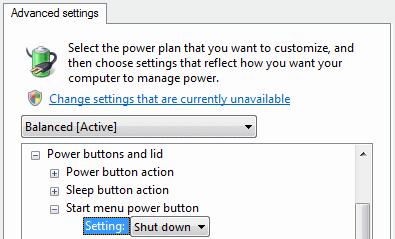
Met het volgende resultaat:

The computer can be set to sleep manually using the lock options in the start menu. Another option is to program the on/off button (and possibly to sleep-button) on the computer by Choose what the power buttons do (at the left in the task pane of Power Options) to put the computer to sleep or hibernate when the button is pressed (after this change it is only possible to switch off the computer by the start menu!).
DISABLE THE WELCOME SCREEN AFTER WAKING UP FROM SLEEPWindows shows the welcome screen by default after the computer returns from sleep or hibernation, even if the user account isn't provided with a password! This security option can be disabled by the sub Power Options in the control panel. Select the task Require a password on wakeup in the task pane, click the link Change settings that are currently unavailable and activate the option Don't require a password. |
© 2001-2022 - Menno Schoone - SchoonePC - Rotterdam - The Netherlands